Implant Planning and Treatment Steps
The success of your implant treatment is a team effort. You can maximize your chance of success by taking full advantage of specialization — the surgical expertise of Dr. Stout to carry out implant and bone reconstruction treatments and the restorative expertise of your dentist to carry out the prosthetic (tooth crown and denture) treatments.

At your consultation visit, we examine your teeth and gums, the occlusion (the way your teeth bite together), and the jaw anatomy. Utilizing 3-dimensional CT scans, and photos, and CAD virtual surgical planning, we conference with your dentist to ensure we recommend the most ideal treatment for you.
The treatment concept of dental implants is actually very simple. We surgically create a precision socket in the jaw bone into which a titanium root is fitted. Once the implant has healed solidly with the bone, the tooth restorations can be completed. In some cases, usually in the front teeth, the gum tissues need to be sculpted or grafted to obtain an ideal cosmetic result.




Left to right: the incision, preparing bone for implant, implant with abutment connector, final prosthesis.
For many implant locations, it is best to wait for the bone to heal completely from tooth extractions before proceeding with implant surgery. Sometimes it is possible to remove hopeless teeth and place the implants all in one procedure, which shortens your treatment time.
You will not need to go without teeth during your treatment. During all the surgical healing steps, you can wear temporary restorations. In certain cases, implants can be fitted with an immediate non-removable prosthesis at the time of implant surgery. This is known as “Teeth in a Day” treatment.
Learn more about Teeth in a Day.
Your Implant Surgery
The actual implant placement surgery is done in our office surgery center with the aid of intravenous sedation anesthesia. The procedures are simple and take less than an hour.
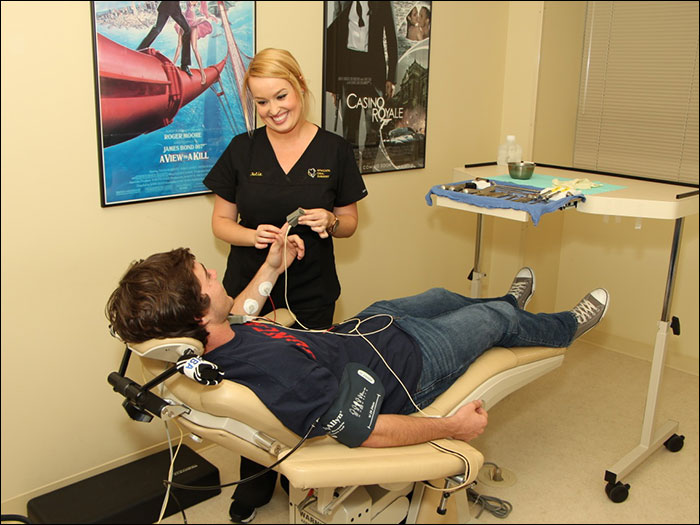
We don’t start your procedure until you are comfortably asleep. Once we have finished your treatment, you will awaken from the sedation rather quickly (It feels like only 3-4 seconds have elapsed). You will be comfortable since the area will be numb. Once you return home, it is best to keep your activity light for a day or two.
We will make sure you are comfortable during your recuperation. The discomfort after implant surgery is surprisingly mild, but prescription pain medication will be available. It is best to be on a soft diet for a few days and avoid chewing in the surgical area.
Click here for a more complete set of instructions for recovery and wound care.
Attaching Teeth to the Implants
Once your implants have healed solidly with the bone with healthy surrounding gum tissues, the restorative phase begins.
Replacing One or Several Teeth
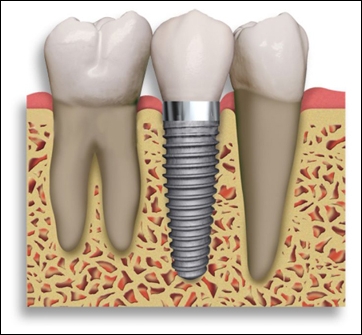 Once your implants have fused with the bone and have a healthy layer of gum tissues surrounding them, the implants can be restored with teeth in several different ways, depending on your restorative goals.
Once your implants have fused with the bone and have a healthy layer of gum tissues surrounding them, the implants can be restored with teeth in several different ways, depending on your restorative goals.
After taking impressions and recording your natural tooth color, your restoring dentist works closely with the laboratory technician to fabricate the permanent crown or bridge restorations that match your natural teeth in appearance and function.
Most of the time, one implant is placed for each missing tooth root. If several adjacent teeth are missing, two or more implants can be connected to create an implant bridge.
Implant Overdenture
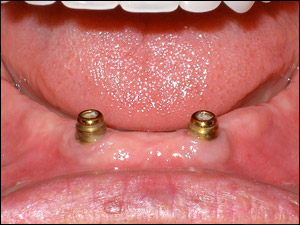
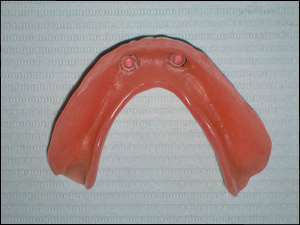
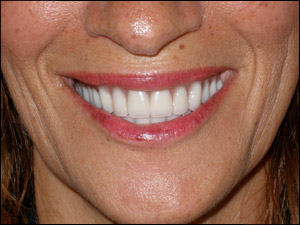
Actual patient treated with an implant overdenture.
If all the teeth in a jaw are missing, two or four implants are placed and a modified denture is made that snaps securely onto the implants. There is dramatic improvement in stability, comfort and function, no matter how long teeth have been missing. This implant overdenture is a common and cost-effective solution.
Using four implants on the upper jaw, an overdenture can even be made with the palate (roof of the mouth) completely open. Your denture will feel less bulky and more natural, and you can recapture the taste and enjoyment of foods.
Full-Arch Implant Crowns
All the missing teeth in an entire jaw can be replaced with a permanent, non-removable prosthesis. The teeth will appear to be emerging naturally out of your gum tissue and will most closely resemble the appearance, feel, and function of your natural teeth. This option requires 4 to 6 implants, and can often be done with an immediate non-removable temporary prosthesis, a technique known as “Teeth in a Day.”
Click here to learn more about Teeth in a Day.
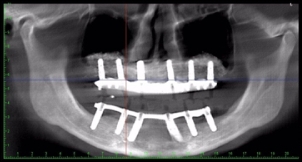

Left: x-ray of full arch implants. Right: the access holes of the prosthesis are filled in with tooth shade restoration.
Bone Graft Reconstruction
After teeth are lost, the jawbone immediately begins to resorb and shrink, a process known as atrophy. To prevent this, a socket bone graft is placed at the time of extraction. Timely extraction of hopeless teeth is also very important. Delaying extraction of diseased teeth can be a disaster. In the end there is greater bone loss, requiring more extensive bone graft reconstruction and potential compromise to your final result.
Deficient or atrophied areas of the jaw can be reconstructed by grafting with your own harvested bone, human donor bone (non-living graft from a tissue bank), or a synthetic human bone growth hormone (BMP). Most bone grafting procedures are minor and can be done simultaneously with the implant placement. If there is severe atrophy, the bone graft must be placed and allowed to heal before implants can be placed.
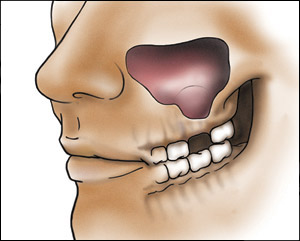
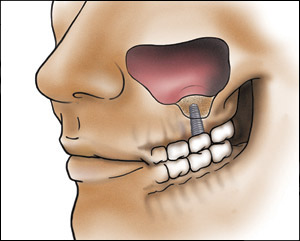
Implants placed in conjunction with sinus lift bone graft.
When upper molar teeth are lost, the sinus cavities lying just above the sockets commonly enlarges and extends into the area where the tooth roots used to be. A grafting procedure called a sinus lift bone graft may be needed to restore jawbone height.